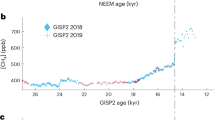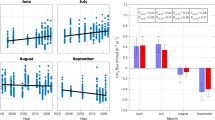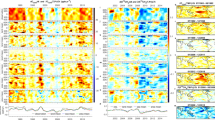Abstract
Past atmospheric methane concentrations show strong fluctuations in parallel to rapid glacial climate changes in the Northern Hemisphere1,2 superimposed on a glacial–interglacial doubling of methane concentrations3,4,5. The processes driving the observed fluctuations remain uncertain but can be constrained using methane isotopic information from ice cores6,7. Here we present an ice core record of carbon isotopic ratios in methane over the entire last glacial–interglacial transition. Our data show that the carbon in atmospheric methane was isotopically much heavier in cold climate periods. With the help of a box model constrained by the present data and previously published results6,8, we are able to estimate the magnitude of past individual methane emission sources and the atmospheric lifetime of methane. We find that methane emissions due to biomass burning were about 45 Tg methane per year, and that these remained roughly constant throughout the glacial termination. The atmospheric lifetime of methane is reduced during cold climate periods. We also show that boreal wetlands are an important source of methane during warm events, but their methane emissions are essentially shut down during cold climate conditions.
This is a preview of subscription content, access via your institution
Access options
Subscribe to this journal
Receive 51 print issues and online access
$199.00 per year
only $3.90 per issue
Buy this article
- Purchase on Springer Link
- Instant access to full article PDF
Prices may be subject to local taxes which are calculated during checkout



Similar content being viewed by others
References
North Greenland Ice Core Project members. High resolution climate record of the northern hemisphere reaching into the last interglacial period. Nature 431, 147–151 (2004)
Johnsen, S. J. et al. Irregular glacial interstadials recorded in a new Greenland ice core. Nature 359, 311–313 (1992)
Dällenbach, A. et al. Changes in the atmospheric CH4 gradient between Greenland and Antarctica during the last glacial and the transition to the Holocene. Geophys. Res. Lett. 27, 1005–1008 (2000)
Spahni, R. et al. Atmospheric methane and nitrous oxide of the late Pleistocene from Antarctic ice cores. Science 310, 1317–1321 (2005)
Petit, J. R. et al. Climate and atmospheric history of the past 420,000 years from the Vostok ice core, Antarctica. Nature 399, 429–436 (1999)
Sowers, T. Late Quaternary atmospheric CH4 isotope record suggests marine clathrates are stable. Science 311, 838–840 (2006)
Schaefer, H. et al. Ice record of δ13C for atmospheric CH4 across the Younger Dryas–Preboreal transition. Science 313, 1109–1112 (2006)
EPICA community members. One-to-one coupling of glacial climate variability in Greenland and Antarctica. Nature 444, 195–198 (2006)
Khalil, M. A. K., Shearer, M. J. & Rasmussen, R. A. in Atmospheric Methane: Sources, Sinks, and Role in Global Change (ed. Khalil, M. A. K.) 168–179 (Springer, Berlin, 1993)
Quay, P., Stutsman, J., Wilbur, D., Dlugokencky, E. & Brown, T. The isotopic composition of atmospheric methane. Glob. Biogeochem. Cycles 13, 445–461 (1999)
Whiticar, M. J. in Atmospheric Methane: Sources, Sinks, and Role in Global Change (ed. Khalil, M. A. K.) 138–167 (Springer, Berlin, 1993)
Kennett, J. P., Cannariato, K. G., Hendy, I. L. & Behl, R. J. Carbon isotopic evidence for methane hydrate instability during Quaternary interstadials. Science 288, 128–133 (2000)
Brook, E. J., Harder, S., Severinghaus, J., Steig, E. J. & Sucher, C. M. On the origin and timing of rapid changes in atmospheric methane during the last glacial period. Glob. Biogeochem. Cycles 14, 559–572 (2000)
Keppler, F., Hamilton, J. T. G., Braß, M. & Röckmann, T. Methane emissions from terrestrial plants under aerobic conditions. Nature 439, 187–191 (2006)
Dueck, T. A. et al. No evidence for substantial aerobic methane emission by terrestrial plants: a 14C-labelling approach. New Phytol. 10.111/j.1469–8137.2007.02103.x (2007)
Chappellaz, J. et al. Synchronous changes in atmospheric CH4 and Greenland climate between 40 and 8 kyr bp. Nature 366, 443–445 (1993)
Chappellaz, J. et al. Changes in the atmospheric CH4 gradient between Greenland and Antarctica during the Holocene. J. Geophys. Res. 102, 15987–15997 (1997)
Flückiger, J. et al. N2O and CH4 variations during the last glacial epoch: Insight into global processes. Glob. Biogeochem. Cycles 18 10.1029/2003GB002122 (2004)
Ferretti, D. F. et al. Unexpected changes to the global methane budget over the past 2000 years. Science 309, 1714–1717 (2005)
Ruddiman, W. F. The anthropogenic greenhouse era began thousands of years ago. Clim. Change 61, 261–293 (2003)
Cantrell, C. A. et al. Carbon kinetic isotope effect in the oxidation of methane by the hydroxyl radical. J. Geophys. Res. 95, 22455–22462 (1990)
Tyler, S. C., Crill, P. M. & Brailsford, G. W. 13C/12C fractionation of methane during oxidation in a temperate forested soil. Geochim. Cosmochim. Acta 58, 1625–1633 (1994)
Saueressig, G., Bergamaschi, P., Crowley, J. N., Fischer, H. & Harris, G. W. Carbon kinetic isotope effect in the reaction of CH4 with Cl atoms. Geophys. Res. Lett. 22, 1225–1228 (1995)
Lelieveld, J., Crutzen, P. & Dentener, F. J. Changing concentration, lifetime and climate forcing of atmospheric methane. Tellus 50B, 128–150 (1998)
Kaplan, J. O., Folberth, G. & Hauglustaine, D. A. Role of methane and biogenic volatile organic compound sources in late glacial and Holocene fluctuations of atmospheric methane concentrations. Glob. Biogeochem. Cycles 20 10.1029/2005GB002590 (2006)
Valdes, P. J., Beerling, D. J. & Johnson, C. E. The ice age methane budget. Geophys. Res. Lett. 32 10.1029/2004GL021004 (2005)
Mahowald, N. et al. Dust sources and deposition during the last glacial maximum and current climate: A comparison of model results with paleodata from ice cores and marine sediments. J. Geophys. Res. 104, 15895–15916 (1999)
Kaplan, J. O. Wetlands at the Last Glacial Maximum: Distribution and methane emissions. Geophys. Res. Lett. 29 10.1029/2001GL013366 (2002)
Thonicke, K., Prentice, I. C. & Hewitt, C. Modeling glacial-interglacial changes in global forest fire regimes and trace gas emissions. Glob. Biogeochem. Cycles 19 10.1029/2004GB002278 (2005)
Walter, K. M., Edwards, M. E., Griosse, G., Zimov, S. A. & Chapin, F. S. Thermokarst lakes as a source of atmospheric CH4 during the last deglaciation. Science 318, 633–636 (2007)
Acknowledgements
This work is a contribution to EPICA, a joint European Science Foundation/European Commission scientific programme, funded by the EU and by national contributions from Belgium, Denmark, France, Germany, Italy, the Netherlands, Norway, Sweden, Switzerland and the United Kingdom. The main logistical support was provided by IPEV and PNRA (at Dome C) and AWI (at Dronning Maud Land). This is EPICA publication no. 190. We thank I. Levin for providing reference air samples and for comments on the manuscript. We thank the logistics team (led by C. Drücker), the drilling team (led by F. Wilhelms) and all helpers in the field at EDML for making the science possible. Financial support for this study has been provided in part by the German Secretary of Education and Research program GEOTECHNOLOGIEN and Deutsche Forschungsgemeinschaft.
Author information
Authors and Affiliations
Corresponding author
Supplementary information
Supplementary Information
The file contains Supplementary Methods with additional references and Supplementary Tables S1-S2. The Supplementary Material provides details on the gas chromatography isotope ratio mass spectrometry (GC irmMS) method developed in this study to derive δ13CH4 in ice core samples. In addition details on the box model for the atmospheric methane cycle, the Monte Carlo approach and the sensitivity of the model of the choice on model parameters are given. The supplementary material includes supplementary table S1 (isotopic signature of sources and isotopic fractionation of sinks used in the model) and supplementary table S2 (Monte Carlo model estimates of source emissions and lifetime). (PDF 154 kb)
Supplementary Table
The file contains Supplementary Table S3 which includes δ13CH4 data from the EPICA Dronning Maud Land ice core over the last glacial/interglacial transition on the Greenland GICC05 age scale after methane synchronization as shown in Fig. 2. Given are δ13CH4 values after corrections for measurement offsets as well as δ13CH4 values after correction for gravitational enrichment in the firn column in ‰ relative to VPDB (see supplementary material for more details). (XLS 15 kb)
Rights and permissions
About this article
Cite this article
Fischer, H., Behrens, M., Bock, M. et al. Changing boreal methane sources and constant biomass burning during the last termination. Nature 452, 864–867 (2008). https://doi.org/10.1038/nature06825
Received:
Accepted:
Issue Date:
DOI: https://doi.org/10.1038/nature06825
This article is cited by
-
Atmospheric methane variability through the Last Glacial Maximum and deglaciation mainly controlled by tropical sources
Nature Geoscience (2023)
-
Nitrate-Dependent Anaerobic Methane Oxidation in Subtropical Mangrove Soils and Environmental Implication
Wetlands (2023)
-
Reconciling glacial Antarctic water stable isotopes with ice sheet topography and the isotopic paleothermometer
Nature Communications (2018)
-
Antarctic and global climate history viewed from ice cores
Nature (2018)
-
Molecular and stable isotopic evidence for the occurrence of nitrite-dependent anaerobic methane-oxidizing bacteria in the mangrove sediment of Zhangjiang Estuary, China
Applied Microbiology and Biotechnology (2018)
Comments
By submitting a comment you agree to abide by our Terms and Community Guidelines. If you find something abusive or that does not comply with our terms or guidelines please flag it as inappropriate.



